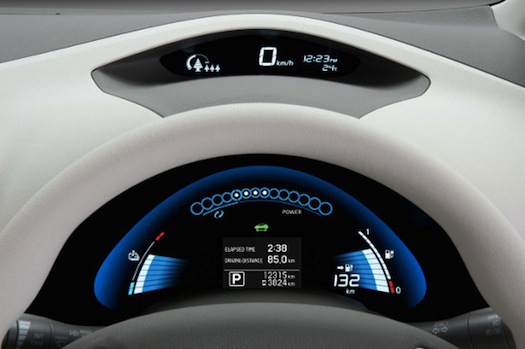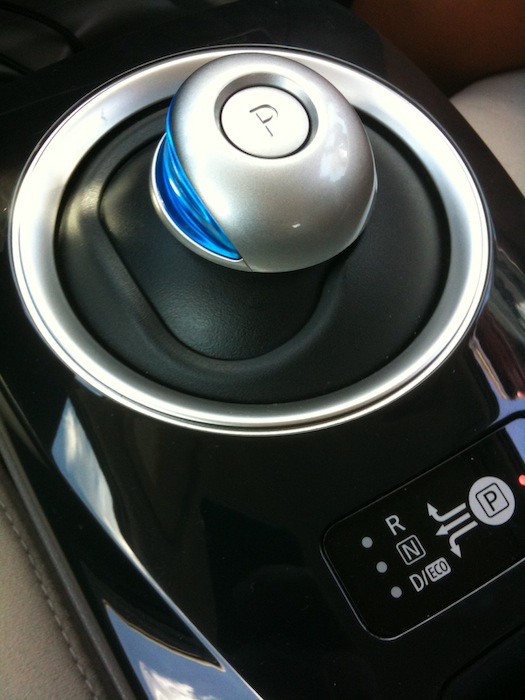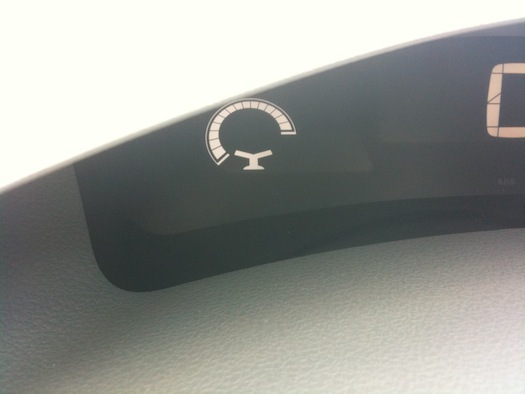
Leaves and vines grow on the Ford Fusion dashboard in proportion to conserved energy.
Many features of a car reveal personality as much as performance. The instrument panel used to tell many tales — of water temperature and oil pressure, amps and volts, revolutions per minute and pounds per square inch. With the modern car all that mattered was the speedometer, odometer and maybe tachometer. As manual transmission fades away, the tach can vanish as well.
At the same time, new technology under the hood is augmenting the instrument panel’s design. Such tools as the “eco indicator” have joined the usual gauges behind the steering wheel, not only to inform and warn, but also to coach and scold. They help sell new technologies, soothing wary buyers.
In fact, the instrument panels of electric cars and hybrids are as different from those of conventionally powered vehicles as batteries and motors are from the gears and pistons of the past. They wrap new technology in interfaces that both excite and reassure. They make drivers feel good about themselves. And they use game-like strategies to encourage them to drive more efficiently.
Decades ago, BMW offered a simple needle for fuel consumption — it bobbed up along with the RPM. More recently, “upshift” lights coached drivers of manual transmission Saab 9000 Aero and Volkswagen Golf diesels. The arrival of the cheap trip computer, a function now built into the instrument panels of moderate-priced and even rental-level cars, lets many drivers follow their instant or average MPG.

Charting efficiency in Toyota's Prius, where conservation is often regarded as a game.
Today’s drivers of hybrids face a different array of instruments. Prius owners get used to the novelty quickly. Several I talked to said they had spent a lot of time trying to “drive green” when their cars were new, even entering their results proudly on a website. They become more casual about glancing at the “eco” gauge. “Now it’s a kind of game,” one owner confessed, enlivening a dull drive the way a hand of computer solitaire eases the tedium of a boring business meeting.
Ford designers encouraged green driving by taking the idea further. The company recently received a patent for its leaf and vine “EcoGuide,” developed with input from IDEO and Smart Design and used in the Ford Fusion and Lincoln MKX hybrids. Drive with a gentle foot, and the leaf grows and blooms. The graphic, Ford reports, “also displays how many miles per gallon a vehicle is getting at any given moment and estimates how many more miles a vehicle has until it runs out of fuel.”
Electrics take new gauges. Mitsubishi’s I-Miev, which I tested last year, has a pretty simple range indicator.
The Chevrolet Volt is General Motors’ “extended range” electric car with an added small engine. The gasoline motor kicks in when the car exceeds its 40-mile or so battery range.

Inside the Chevrolet Volt.
The gauge in the Volt displays its remaining electricity, in miles of range, as a cylinder shape on the computer IP. The form suggests a track event’s relay baton but the glowing, greenish color makes it look like some radioactive liquid from a video game view of a nuclear reactor fuel rod.
On the other side of the display, a bouncing circle reveals the driver’s efficiency. The shape resembles a green Wiffle ball suspended on a column of air. Heavy-footed drivers will see the ball sink into a yellowish area.
Nissan took the Leaf, an all-electric with roughly a hundred-mile range, on a national tour this summer. A team of eager young explainers traveled with the tents, portable computer displays and clutch of new cars. “It’s like the circus,” said Abe Quigley, a self-described product specialist.
Each exhibit was devoted to reassuring customers about the new technology. At one stand, visitors were asked to choose a zip code and outline a daily driving routine. The Nissan helpers located the stops — grocery store, office, gym — on a Google map and toted up the miles. “It is usually way less than they think,” Quigley said. “They guess they drive 70 and it turns out to be 30.” “
There is usually this light bulb moment when they realize, ‘Hey it is a regular car.’”
Regular? The silent Leaf is set in action with a push button, but only a visual display — an illuminated silhouette on the dash — signals that it’s running and read to go. When I first drove the car, I pushed and waited, not sure. An eager chime or chirp would have been helpful.

Nissan Leaf gauges.
The shifter, a blue dome on the central console, hints at the designers’ approach: to make the Leaf seem more like a consumer electronic product than a traditional car. The controller’s circular form suggests that it should be turned like an audio knob. Alternatively (and probably more in line with the designers’ intention), the shape recalls a mouse or track ball with 360 degrees of controlling motion. In fact this dome really controls only a single axis and three positions: forward, reverse and “eco,” the energy-efficient mode of driving that makes the car distinctly less quick to accelerate. You push the “P” button in the center for park. Very simple. But the visual presentation is confusing.

The Leaf's shifter resembles a game controller. The display of driving modes, though simple, is graphically confusing.
On the display screen, two fan-like gauges show range while an arc of rings sweeping across the screen marks the driver’s efficiency. The digital speedometer, a simple large number, is on top.
If Ford’s leaf and flower system makes green driving a kind of game, Nissan’s shifter provides a direct choice: put the car in the eco mode and it gets sluggish. Fun and green are diametrically opposed, a couple of inches apart on the console — a stark choice.
But there is another alternative.
I mentioned to the Leaf crew the leaves and blossoms in the Ford hybrids. “We have a tree,” they responded with excitement. They pointed to a shape in a different area of the panel: an “eyebrow” window above the basic instrument panel where the digital speedometer resides.
The tree was so stylized and geometric — more “T” than tree — that I hadn’t recognized it. Surrounding the icon was a circle of notches or dashes that represented cumulative green driving — somehow. The Nissan specialists weren’t quite sure how it worked. The company, I was told, will let drivers digitally “plant” their trees on a website, reveling in their green behavior. (Volkswagen, for its part, plants literal carbon-offsetting trees in a forest in northwestern Louisiana.)

A tree symbol on the Leaf's instrument panel is so stylized as to be unrecognizable.
But I couldn’t stop staring at that tree icon on the dashboard. It made me think of the logo of, say, an investment firm wishing to be known for its patience and stability.
Or perhaps it’s the shape a tree takes when it’s hugged into abstraction.


Comments [1]
09.02.11
10:44